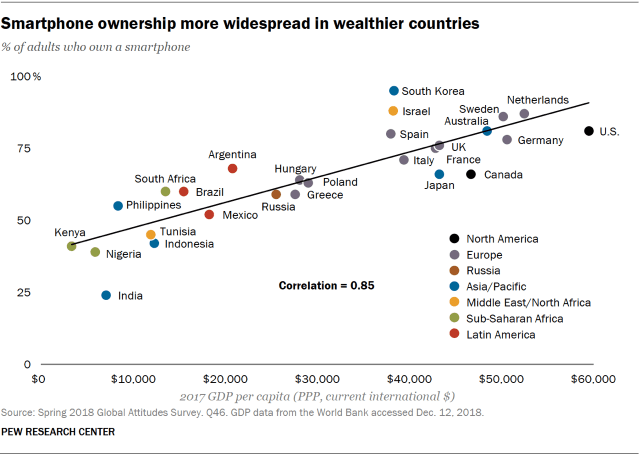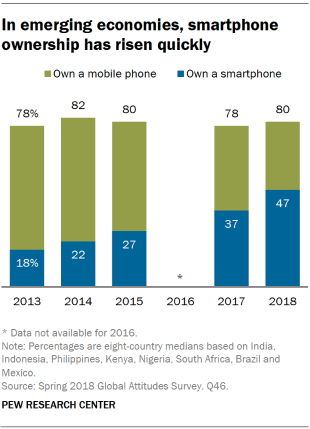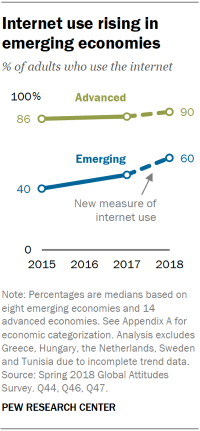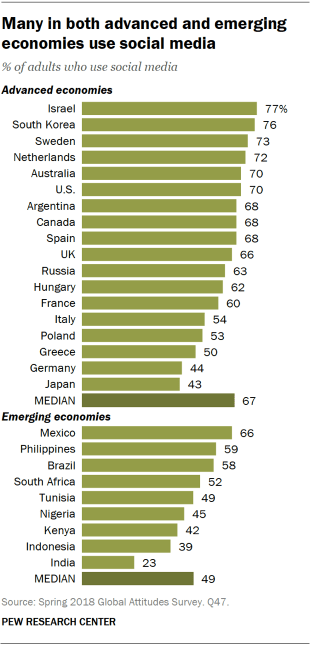In all 27 countries surveyed, majorities of people own a mobile phone. In advanced economies such as South Korea and France, ownership rates are upwards of 90%. Mobile phones are increasingly common in emerging economies as well. Across the nine emerging economies surveyed, a median of 83% report owning a mobile phone, including nine-in-ten or more in Tunisia (90%) and South Africa (94%).
Smartphone adoption also continues to increase in emerging nations. While the share of the public that owns a smartphone remained largely unchanged between 2017 and 2018 in most advanced economies surveyed – due to the already high ownership rates evident in 2017 – it increased in eight of the nine developing economies surveyed.
Despite these increases in smartphone ownership, emerging economies still trail advanced economies. About six-in-ten or more own a smartphone in every advanced economy surveyed, while only two emerging economies surveyed reach that threshold. Among emerging economies, rates of ownership range from a low of 24% in India to a high of 60% in Brazil and South Africa.
Across all 27 countries surveyed, there is a strong relationship between smartphone ownership and per capita gross domestic product (by purchasing power parity, or PPP) – a trend which has held steady since the question was first posed in 2015.

Smartphones are increasingly the most common mobile phone

Today, most people who own a mobile phone own a smartphone. But in emerging economies, this was not the case even a few years ago. As recently as 2015, a median of 80% owned a mobile phone of any sort, while a median of only 27% owned a smartphone. Over the past three years, while mobile phone ownership overall has held steady, smartphones have made up a much larger share of mobile devices owned. Today, a median of nearly half own a smartphone.
For example, three years ago, 89% of South Africans owned a mobile phone. Today, the share who own a mobile phone of some kind has ticked up to 94%, while smartphone ownership has grown from just over a third (37%) to a majority of the population (60%).
Even as smartphone ownership has climbed year-over-year in these emerging economies, a sizable minority of roughly one-in-five has reported not owning a mobile phone of any kind each year since 2013. In Brazil, for example, smartphone ownership has quadrupled since 2013, increasing from 15% of the public to 60% today. But mobile phone ownership overall has remained steady: At both points in time, roughly eight-in-ten Brazilians owned a mobile phone.
In emerging economies, internet use is growing rapidly

Internet use is nearly universal in most advanced economies surveyed. In the United States, Sweden, Australia, the Netherlands, Israel and South Korea, more than nine-in-ten use the internet. And in emerging economies, about half or more use the internet in every country but India.
Usage is also growing rapidly in these emerging economies. For example, five years ago less than half of the Mexican public (45%) and only about a third of Filipinos (34%) used the internet at least occasionally or owned a smartphone. Today, internet use in these countries stands at 73% and 66%, respectively.
But these internet use estimates are complicated by an evolving understanding of what “using the internet” means. Previous Pew Research Center surveys have calculated internet use based on the share of the public who either report using the internet at least occasionally or who say they own a smartphone. These individuals were then the only ones who were asked whether they used social media or not.
This year, however, everyone was asked whether they ever use online social media sites like Facebook or Twitter – even if they said they did not own a smartphone or use the internet. Results indicate that there is a small but noteworthy share of people who report using social media but who say they do not use the internet. For example, around one-in-six Kenyans (14%) who report using social media say they do not use the internet. We therefore define “internet users” as anyone who uses social media or owns a smartphone, even if they report not using the internet (see Appendix D for more information).
Social media use more common in advanced than emerging economies

Even as internet use has grown in emerging economies, social media use is somewhat less widespread: A median of around half (49%) report using social networking sites. This varies widely across the countries surveyed. In Mexico, the Philippines, Brazil and South Africa, half or more report using social media. In contrast, only around a quarter of Indians use social media sites.
Notably, the differences in social media use across advanced and emerging economies do not follow the same patterns evident with smartphone ownership. For example, Americans, Canadians and Mexicans all have roughly similar levels of social media use, even though Americans and Canadians report higher smartphone ownership than Mexicans. And about as many Germans (44%) as Nigerians (45%) access social networking sites, despite smartphone ownership among Germans being twice as high as among Nigerians.
Some of this disconnect is likely because social networking sites can be accessed via smartphone or from other platforms. But, while people can and do use social media from multiple devices, in every country surveyed, smartphone owners are much more likely to access social networking sites than people who own a basic phone or none at all.



